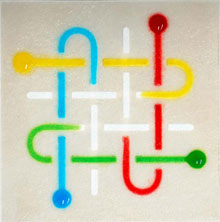Diagnosing Disease with Paper and Tape
On the desk of Harvard University professor George Whitesides are white sheets the size of stamps. Each is inlaid with a different pattern: a four-leaf flower, concentric circles surrounding four dots, a six-pointed burst. These prototypes are diagnostic tests made from a cheap, universally available substrate: paper. With the simple addition of tape, Whitesides and his group have been able to turn their paper tests into three-dimensional devices, allowing for more-complicated analysis. Such paper “lab on a chip” tests may lead to a cost-effective, portable, and accurate method for diagnosing diseases in countries lacking reliable health care.

Whitesides holds up his group’s latest development: a square slightly thicker than the other samples, covered in a grid of yellow, greed, red, and blue dots. This prototype is made up of layers of patterned paper, between which are waterproof double-sided tape. By layering the squares and connecting them with tape adhesive, the group is able to channel liquid horizontally and vertically in a very small area, as detailed in this week’s Proceedings of the National Academy of Sciences.
Each square of paper–which naturally soaks up liquid in its fibers–has been treated with photoresist material, to create channels that funnel liquid to tiny wells coated with proteins or antibodies. The fluid interacts with that area of the paper and turns the well a certain color, changing hues, for example, with varying concentrations of glucose.
“You can effectively make three-dimensional systems,” says Whitesides. “You can distribute fluid from a single point of origin to multiple points elsewhere.” Most microfluidic systems, he adds, require sophisticated piping to channel the fluid, but just by drawing water-resistant channels in the paper and using waterproof tape, the researchers have been able to control the movement of the liquid.
A sample of biological fluid is pressed onto one side of the paper chip. Photoresist channels guide the fluid to certain wells and ultimately through a tiny hole in the waterproof tape, which funnels the liquid on to the next piece of paper. This process continues for each layer of the chip, and the results appear in a dotted grid on the final layer.

According to Whitesides, “Each dot would be a different test” that could be performed using a single drop of blood serum. Currently, the researchers layer the paper and tape by hand, which Whitesides says is fairly easy to do, but they hope that eventually a device could be made to print the tape and paper.
The group has focused on readily accessible materials, so the device can be robust and used in a variety of environments and in developing countries. They chose paper because its natural capillary action circumvents the need for expensive or cumbersome pumps and power sources to move the liquid (as would be needed for polymer or glass microfluidic devices). In that way, the device is similar to how pH paper or a pregnancy test works. But Whitesides aims for his tests to diagnose much more, as well as be portable, cheap to manufacture, and easy for those in developing countries or in military or emergency respond teams to use and adapt.
“These paper-based devices may allow significantly cheaper and portable analytical devices for diagnostics in the developing countries,” says Mehmet Fatih Yanik, an assistant professor of electrical engineering at MIT, who works on lab-on-a-chip imaging. “They could also allow routine conduction of hundreds of assays cheaply, which may allow early and precise diagnostics of severe diseases, significantly reducing the health-care burden,” he adds.
Although the tests are still in the research and development phase, Whitesides says, so far, they seem to be highly accurate. Whitesides has already cofounded a nonprofit, Diagnostics for All, to further develop and distribute the tests in a developing country. (Diagnostics for All won the MIT $100K Entrepreneurship Competition earlier this year.)
The researchers have also begun work on coupling the paper tests with cell phones, so that the results can be photographed, sent to a center, and read by a technician who can send recommendations back via phone.
Keep Reading
Most Popular
Large language models can do jaw-dropping things. But nobody knows exactly why.
And that's a problem. Figuring it out is one of the biggest scientific puzzles of our time and a crucial step towards controlling more powerful future models.
The problem with plug-in hybrids? Their drivers.
Plug-in hybrids are often sold as a transition to EVs, but new data from Europe shows we’re still underestimating the emissions they produce.
Google DeepMind’s new generative model makes Super Mario–like games from scratch
Genie learns how to control games by watching hours and hours of video. It could help train next-gen robots too.
How scientists traced a mysterious covid case back to six toilets
When wastewater surveillance turns into a hunt for a single infected individual, the ethics get tricky.
Stay connected
Get the latest updates from
MIT Technology Review
Discover special offers, top stories, upcoming events, and more.